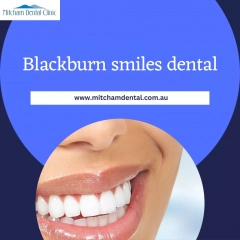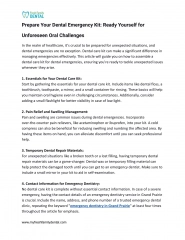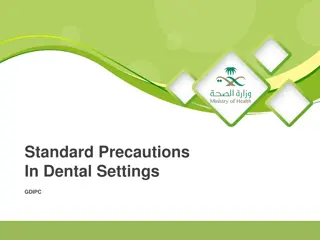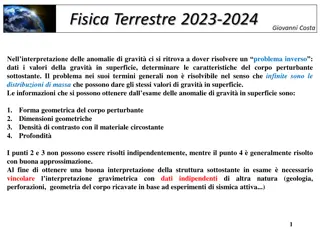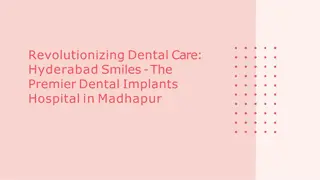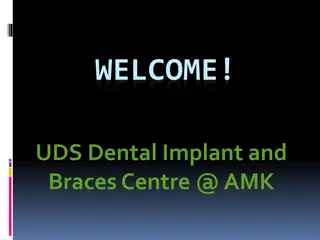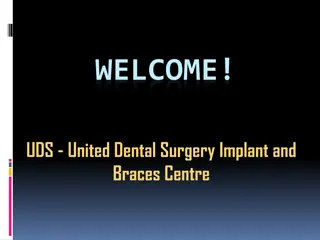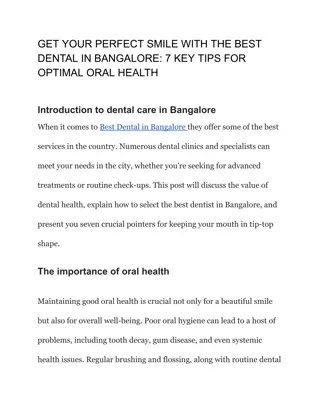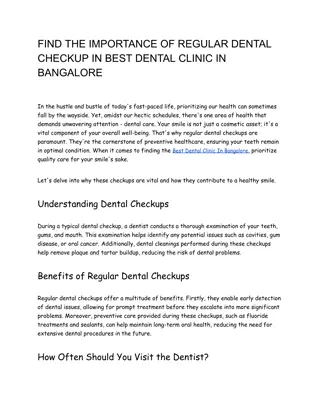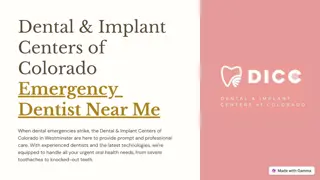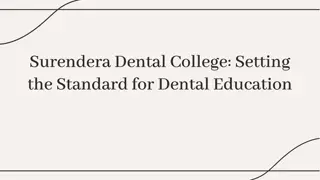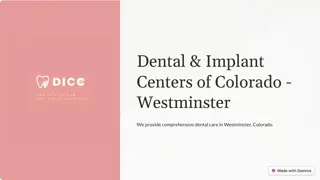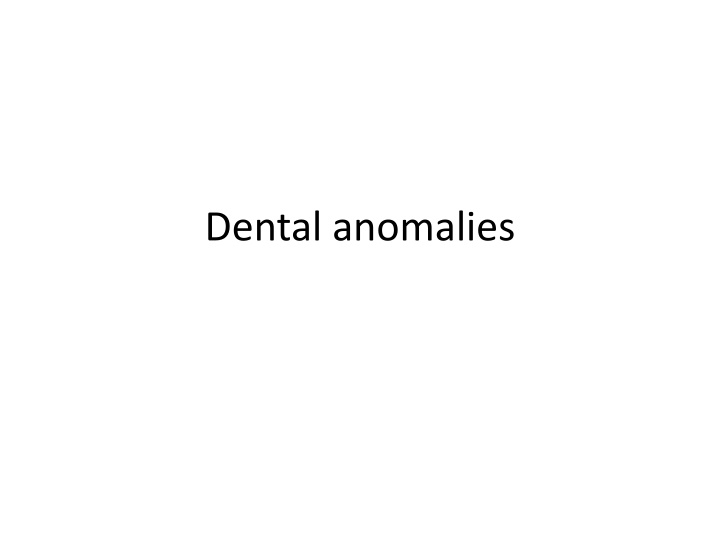
Understanding Dental Anomalies and Abnormalities in Tooth Development
Explore dental anomalies like supernumerary teeth, missing teeth, size variations, and developmental abnormalities affecting the eruption and morphology of teeth. Learn about complications and treatments associated with these conditions.
Download Presentation

Please find below an Image/Link to download the presentation.
The content on the website is provided AS IS for your information and personal use only. It may not be sold, licensed, or shared on other websites without obtaining consent from the author. If you encounter any issues during the download, it is possible that the publisher has removed the file from their server.
You are allowed to download the files provided on this website for personal or commercial use, subject to the condition that they are used lawfully. All files are the property of their respective owners.
The content on the website is provided AS IS for your information and personal use only. It may not be sold, licensed, or shared on other websites without obtaining consent from the author.
E N D
Presentation Transcript
Developmental abnormalities Number of teeth Eruption of teeth Altered morphology
Supernumerary teeth Syn: hyperdontia, distodens, mesiodens, parateeth, peridens, supplemental teeth Parateeth: those occuring in the molar area Distodens: those that erupt distal to 3rdmolar Peridens: those that erupt ectopically, buccal or lingual to normal arch Single teeth are more common in ant maxilla and in max molar region Multiple in mandibular premolar region Shape: normal appearing to conical and to grossly distorted Size: usually smaller Syndrome: cleidocranial dysplasia, gardner s syndrome
Complication Malalignment of normal dentition Root resorption or interfere with normal eruption sequence Dentigerous cysts
Missing teeth Syn: hypodontia, oligodontia, anodontia Hypodontia: absence of one or few teeth Oligodontia: absence of numerous teeth Anodontia: failure of all teeth to develop Etiology: affect the orderly formation of dental lamina Failure of tooth germ to develop Lack of necessary space imposed by the malformed jaw Genetically determined disproportion b/w tooth mass and jaw size
Most common missing are third molars, second premolars, max lateral and mand centrals Treatment: restorative, implant and prosthesis
Size of teeth Correlation exists b/w tooth size and body height Macrodontia:teeth are larger than normal Teeth are of normal size but occur n smaller jaw, relative macrodontia Hemangioma can result in increase in size True localized macrodontia: hemihypertrophy True gen macrodontia: pit. Gigantism Compications: crowding, malocclusion or imapaction
Microdontia Teeth are smaller than normal Relative microdontia: normal sized teeth develop in large jaws Gen microdontia: pit dwarfism Cl/ f: small teeth and altered morphology Laterals are small and peg shaped Management: esthetic concern
Transposition Here two teeth have changed positions Permanent canine and 1stpremolar 2ndpremolar b/w 1stand 2ndmolar Management: altered prosthetically to improve function and esthetics
Fusion Syn: synodontia Results drom combining of adjacent tooth germs, resulting in union of the developing teeth Etiology: 2 tooth germs close together fuse before calcification Physical force or pressure during development c/f: reduced no of teeth in arch Is more common in anterior region Bifid crown may exist or two teeth may be joined by enamel or dentin
r/g of fusion Unusual shape or size of entire tooth May show unusual configuration of pulp chamber, root canal or crown Management: reshaping with restoration
Concrescence When roots of two or more teeth are united by cementum Can occur in primary or secondary teeth Space restriction during development, local trauma, excessive occlusal force or local infection after development If it occurs during development, true concrescence If after development, acquired concrescence Max molars are most frequently involved Involved teeth may fail to erupt or erupt incompletely
Gemination Is rare, and arises when the tooth bud of a single tooth attempts to divide Result may be an invagination of the crown, with partial division or rarely complete division Most frequently in primary teeth Enamel or dentin of geminated teeth may be hypoplastic or hypocalcified
r/g of gemination r/g reveal altered shape of hard tissue and pulp chamber of geminated tooth R opaque enamel outlines the cleft in crowns and invaginations and thus attenuates them Pulp chamber is usually single and enlarged and may be partially divided Management: esthetically, caries, malocclusion leading to periodontal disease, reshaping
Taurodontism Have longitudinally enlarged pulp chambers Crown is normal in shape and size but body is elongated and roots are s hort Pulp chamber extends throughout the extended body leading to an increased distance b/w CEJ and furcation Extension of rectangular pulp chamber into elongated body of tooth
Dilaceration It is a disturbance in tooth formation that produces a sharp bend or curve in tooth Etiology: mechanical trauma to calcified portion of partially formed tooth If severe dilaceration, tooth doesn t erupt Mesial or distal bend is seen on r/g Buccal or lingual bend, central passes passes approx parallel with deflected portion of root Appears a rounded opaque area with a dark shadow in its central region cast by the apical foramen and root canal, PDL space may be seen as a r lucent halo
Dens in dente Syn: dens invaginatus, dilated odontome, gestant odontome Results from an infolding of the outer surface into the interior of a tooth Can occur either in crown or root during tooth development and may involve pulp chamber or root canal, resulting in deformity of either crown or root Dilated odontome: the most extreme form of anomaly
When dens in dente involves a root, it appears to be the result of an invagination of Hertwig s ept root sheath, resulting in an accentuation of normal longitudinal root groove Defect is lined by cementum Coronal variety may be seen as a pit at incisal edge or cingulum Pit may be broad and deep and lingual marginal ridges and cingulum prominent Clinical importance: risk of pulpal disease Enamel lining the coronal defect is frequently thin
Dens evaginatus Syn: Leong s premolar It is the result of an outfolding of enamel organ Results in enamel covered tubercle, usually in or near the middle of the occlusal surface of a premolar or occasionally a molar A polyp like protuberance exists in the central groove or lingual ridge of a buccal cusp Can occur bilaterally and in mandible Tubercle has a dentin core and slender pulp horn Dentine core is surrounded with opaque enamel
Amelogenesis imperfecta It is a developmental disturbance that interferes with normal enamel formation It leads to marked changes in enamel of all or nearly all teeth in both dentitions Enamel lacks the normal prismatic structure and are resistant to decay Dentin and root form are usually normal Affected teeth erupt late
Clinical features Hypoplasia: enamel fails to develop to its normal thickness It is so thin that the dentin shows through and imparts a yellowish brown color to tooth Enamel may be pitted, rough or smooth and glossy Crowns may not have the usual contour and show roughly square shape Reduced enamel thickness so there is lack of contact Occlusal surfaces are flat with low cusps Anterior open bite may be noted
Hypomaturation Enamel has normal thickness but shows mottled appearance It is softer than normal and may crack away from the crown Color ranges from clear to cloudy white, yellow or brown In one form, teeth appear to be snow capped
Hypocalcification Is more common Crowns are normal in size and shape when they erupt Coz enamel is poorly mineralized, it starts to fracture away shortly after it comes to function Soft enamel abrades rapidly and dentin also wears down rapidly leading to grossly worn down teeth, sometimes to level of gingiva
r/g features Hypoplastic: square shape crown Relatively thin opaque layer and low or absent cusps Enamel density is normal Pitted enamel appears as sharply localized areas of mottled density Hypomaturation: normal enamel thickness Density is same as dentine Hypocalcified: normal enamel thickness Density is less than dentin
Dentinogenesis imperfecta Syn: hereditary opalescent dentin Is a developmental disturbance primarily of dentin Enamel may be thinner than normal Both dentitions are affected Type I is associated with osteogensis imperfecta Tooth roots and pulp chambers are smaller and underdeveloped Primary is affected more with type I Type II no skeletal defects seen
Clinicial features Show a high degree of amber like translucncy and variety of colors from yellow to blue-gray Enamel easily fractures from teeth and crowns wear readily In adults teeth frequently wear down to gingiva Exposed dentin becomes stained Some pts show anterior open bite Color of abraded tooth may show dark brown or even black
Radiographic features Crowns are of normal size with a constriction of cervical region of tooth, showing bulbous appearance Slight to marked attrition of occlusal surface Roots are usually short and slender Both types show partial or complete obliteration of pulp chambers Early in development, teeth show large pulp chambers and get quickly obliterated by dentin formation Ultimately root canals may be absent or thread like Occasional r lucencies are seen with sound teeth
Dentin dysplasia It is rare than DI Type I: radicular variety Type II: coronal variety Type I: normal color and shape Occasionally a slight bluish brown translucency is seen Teeth are misaligned, pts may c/o drifting And state that teeth exfoliate with or no trauma Type II: crowns appear to be of same color, shape and size as in DI
RADIOGRAPHIC FEATURES Type I: roots are either short or abnormally shaped Roots of primary teeth may be only thin spicules Pulp chambers and root canals completely fill in before eruption Type II: obliteration of pulp chamber and reduction in caliber of root canals occurs after eruption As chambers get filled in with dentin, chambers become flame shaped and may show multiple pulp stones Occasionally anterior teeth and premolars develop a pulp chamber that is thistle tube in shape
Regional odontodysplasia Syn: odontogenesis imperfecta Is relatively rare condition in which both enamel and dentin are hypoplastic and hypocalcified Result is localized arrest in tooth development It affects few teeth in a quadrant May affect either dentition
Clinical features Teeth are small and mottled brown as a result of staining of hypocalcifed hypoplastic enamel Teeth are susceptible to caries, are brittle and subject to fracture and pulpal infection Eruption is delayed
Radiographic features Teeth show ghost appearance Pulp chambers are large and wide root canals cz dentin is thin serving to outline the image Roots are short Enamel is thin and less dense than usual Tooth is little more than a shell of hypoplastic enamel and dentin
Enamel pearl Syn: enamel drop, enamel nodule, enameloma It is a small globule of enamel 1-3 mm in diameter that occurs on the roots of molars Enamel pearl has a core of dentin and rarely a pulp horn extending from the chamber of the host tooth Probably formed by Hertwig s ept root sheath before the ept loses its enamel forming potential
Clinical features Most form below the crest of gingiva Found at bifurcation or trifurcation of molars Some lie just apical to CEJ They may predispose to periodontal pocket formation and subsequent periodontal disease r/g: pearl appears smooth, round and density is comparable to crown enamel
Talon cusp Is an anomalous hyperplasia of the cingulum of incisor It results in formation of supernumerary cusp May occur in both dentitions It varies from prominent cingulum tocusp like structure Its outline is smooth It may have a pulp horn extending Represents a supernumerary tooth
Turners hypoplasia Syn: Turner s tooth A permanent tooth with a local hypoplastic defect in its crown It is due to extension of a periapical infection from its deciduous predecessor or mechanical trauma Mandibular premolars are affected It depends on stage of development of tooth It may disturb matrix formation or calcification Hypomineralized area may become stained If insult is severe, crown may show pitting or a pronounced defect

